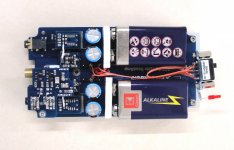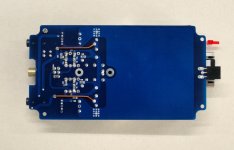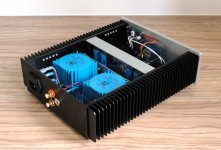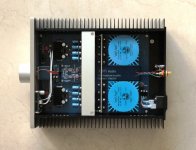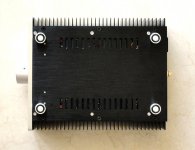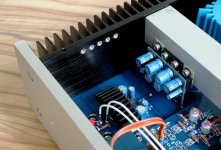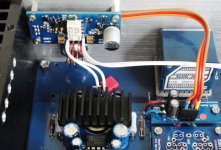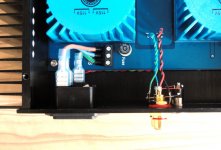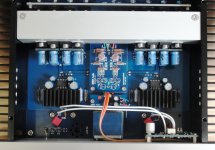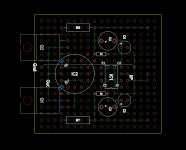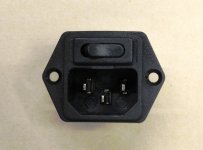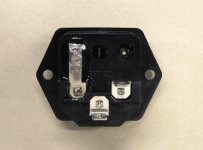That looks great! 🙂
What the final schematic would be?
Do you have time for some measurements?
Regards,
Raul.
What the final schematic would be?
Do you have time for some measurements?
Regards,
Raul.
The schematics is same as before except for a discrete LH0033 replacing the BUF634s.
But the discrete LH0033 is a difficult thing to DIY requiring manual DC trimming.
The schematics of the LH0033 is widely published.
I just use 2SK208, 2SC3324 and 2SA1813, all BL grade and all matched.
What measurement do you want to see ?
THD ?
You might as well just use any opamp like OPA627 or LME49xxx, or the new OPA1622.
They will certainly win that contest.
Bandwidth and square wave response is determined by the AD844.
The LH0033 has bandwidth >> 1MHz.
Patrick
But the discrete LH0033 is a difficult thing to DIY requiring manual DC trimming.
The schematics of the LH0033 is widely published.
I just use 2SK208, 2SC3324 and 2SA1813, all BL grade and all matched.
What measurement do you want to see ?
THD ?
You might as well just use any opamp like OPA627 or LME49xxx, or the new OPA1622.
They will certainly win that contest.
Bandwidth and square wave response is determined by the AD844.
The LH0033 has bandwidth >> 1MHz.
Patrick
Now the desktop version also (95%) finished.
It is a standard 2107 case but using the top plate as vented bottom.
The bottom plate acts as top for now, but will be replaced eventually by a 3mm anti-static tinted plexiglass.
The knob also needs chopping to half the length.
Purely passive Danyuk Cross Feed, XEN modified ALP RK27 Ladder Attenuator, SHPP Protection board.
Bias is stable to 10% in an hour. DC offset < 10mV, without servo.
More details in an article, but later. 🙂
Patrick
.
It is a standard 2107 case but using the top plate as vented bottom.
The bottom plate acts as top for now, but will be replaced eventually by a 3mm anti-static tinted plexiglass.
The knob also needs chopping to half the length.
Purely passive Danyuk Cross Feed, XEN modified ALP RK27 Ladder Attenuator, SHPP Protection board.
Bias is stable to 10% in an hour. DC offset < 10mV, without servo.
More details in an article, but later. 🙂
Patrick
.
Attachments
Thanks. 🙂
I am not known for favouring BJT's, but the AD844 in open loop is a nice sounding thing !!!!
Patrick
I am not known for favouring BJT's, but the AD844 in open loop is a nice sounding thing !!!!
Patrick
As promised the full description :
http://xen-audio.com/documents/xen-zgf/ZGF Desktop Description V1.pdf
Patrick
http://xen-audio.com/documents/xen-zgf/ZGF Desktop Description V1.pdf
Patrick
The power socket that comes with the 2107 case has a fuse holder.
But we already have one on the PCB.
So I want to replace that with a switch.
You could get a new one with a switch from Mouser for 10 Euros (Schurter 4302.0001).
Or you can build a Marquart 1901.1102 toggle switch into the fuse holder.
And I do not like the exposed life conductor, so I encapulated it with epoxy as well.
Patrick
.
But we already have one on the PCB.
So I want to replace that with a switch.
You could get a new one with a switch from Mouser for 10 Euros (Schurter 4302.0001).
Or you can build a Marquart 1901.1102 toggle switch into the fuse holder.
And I do not like the exposed life conductor, so I encapulated it with epoxy as well.
Patrick
.
Attachments
Hi Patrick.
I wonder why you use the LH0033 instead of other buffer? Is there any advantage using it?
I wonder why you use the LH0033 instead of other buffer? Is there any advantage using it?
Yes, a few advantages actually.
1) It has an N-JFET input.
So it has lower noise than e.g. a P-JFET input.
Its high input impedance makes sure that the 39k Zout of the AD844 gain stage does not cause excessive distortion.
And it has next to zero input current, hence no additional DC offset problems.
2) It has separate pins for the output BJT follower.
That allows you to connect two additional power BJT to it to form a Sziklai pair.
3) It has an easy means to allow DC offset adjustment
4) It is still available NOS without costing more than a e.g. BUF634.
5) It's internal circuit is quite simple and easy to build discrete in the same foot print, if necessary.
Patrick
1) It has an N-JFET input.
So it has lower noise than e.g. a P-JFET input.
Its high input impedance makes sure that the 39k Zout of the AD844 gain stage does not cause excessive distortion.
And it has next to zero input current, hence no additional DC offset problems.
2) It has separate pins for the output BJT follower.
That allows you to connect two additional power BJT to it to form a Sziklai pair.
3) It has an easy means to allow DC offset adjustment
4) It is still available NOS without costing more than a e.g. BUF634.
5) It's internal circuit is quite simple and easy to build discrete in the same foot print, if necessary.
Patrick
Yes, a few advantages actually.
1) It has an N-JFET input.
So it has lower noise than e.g. a P-JFET input.
Its high input impedance makes sure that the 39k Zout of the AD844 gain stage does not cause excessive distortion.
And it has next to zero input current, hence no additional DC offset problems.
2) It has separate pins for the output BJT follower.
That allows you to connect two additional power BJT to it to form a Sziklai pair.
3) It has an easy means to allow DC offset adjustment
4) It is still available NOS without costing more than a e.g. BUF634.
5) It's internal circuit is quite simple and easy to build discrete in the same foot print, if necessary.
Patrick
Thank you! That's a very helpful answer 😀
The discrete version that we built has lower noise.
If you use a very sensitive phone, you CAN hear a very slight background noise with the IC.
But the IC is easy to use and quite robust.
So discrete only for those who wants max. performance and know what they are doing.
Patrick
If you use a very sensitive phone, you CAN hear a very slight background noise with the IC.
But the IC is easy to use and quite robust.
So discrete only for those who wants max. performance and know what they are doing.
Patrick
The discrete version that we built has lower noise.
If you use a very sensitive phone, you CAN hear a very slight background noise with the IC.
But the IC is easy to use and quite robust.
So discrete only for those who wants max. performance and know what they are doing.
Patrick
In fact, i have built a discrete version of the LH0033 according to your schematic but the lower ccs jfet is substitute with a npn transistor and led voltage reference and a trimpot to adjust dc offset, the input jfet is 2sk246 10ma idss, output transistor is 2sa1015/2sc1815, i dont have ad844 so i make a headphone amp using simple opamp gain stage then follow by the buffer, it work just fine but not impress me.
In the discrete DPAK version, we used 4 pairs of output BJTs with a total bias of 24mA.
Using the same AD844 gain stage, it beats 5x BUF634 in parallel with ease.
To my ears, with a 70 ohm load, that is.
Patrick
Using the same AD844 gain stage, it beats 5x BUF634 in parallel with ease.
To my ears, with a 70 ohm load, that is.
Patrick
In the discrete DPAK version, we used 4 pairs of output BJTs with a total bias of 24mA.
Using the same AD844 gain stage, it beats 5x BUF634 in parallel with ease.
To my ears, with a 70 ohm load, that is.
Patrick
I will try your buffer with your decision of component, hope it will sound good, btw can you explain for me the use of diode dc1? Thanks!
To compensate the diode drop of Qc5 B-E junction.
What sounds good to me does not have to sound good to you.
Epecially if you like opamp sound or those like Krell, or Class D.
Patrick
What sounds good to me does not have to sound good to you.
Epecially if you like opamp sound or those like Krell, or Class D.
Patrick
To compensate the diode drop of Qc5 B-E junction.
What sounds good to me does not have to sound good to you.
Epecially if you like opamp sound or those like Krell, or Class D.
Patrick
Sorry i dont quite understand here, isn't QC2 is compensate for QC5 Vbe? Btw, i have a question in your other thread, hope you can answer: http://www.diyaudio.com/forums/digi...k4430-dac-module-i2s-input-2.html#post4806990
- Status
- Not open for further replies.
- Home
- Amplifiers
- Headphone Systems
- XEN ZGF Portable Headphone Amplifier
